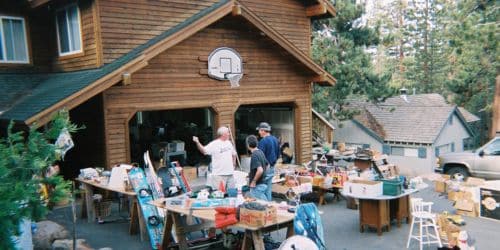To get everything from one house to another, it takes a lot of forethought. And, since moving expenses are inescapable, you might be interested in earning some extra cash before you pack. With spring and summer being peak seasons for relocation and yard sales (or garage, rummage, or tag sales, depending on where you live), now is a perfect time to organize a moving sale to clear away some of your old belongings. Continue reading to find out what you need to do to have a successful sale.
What is a Moving Sale?
Moving sale refers to a public sale or auction performed in advance of a business move within a thirty-mile radius of its current site.
Planning For a Moving Sale.
A lot of preparation goes into a garage sale before the occasion. Starting early (2 to 4 weeks in advance, if possible) will keep you from feeling rushed while you prepare. To prepare for your shoppers, save all of your grocery bags (or buy some cheap waste bags) ahead of time, and then follow these instructions.
#1. Examine the permits and HOA bylaws.
Permits are required in some cities and localities to hold a garage sale. Furthermore, some HOAs have rigorous bylaws. Before you begin planning, check with your local city hall to see if you need a permit to hold a sale. If you reside in an area with an HOA (Homeowners’ Association), check to see if garage sales are permitted and obey any guidelines. Check to discover if there is a community sale day or if your neighbors are arranging sales. Customers that come for several sales in the area may be able to generate extra money.
#2. Choose the best garage sale day.
The majority of yard sales take place on Saturdays, but some folks start on Thursdays or Fridays and extend into Sundays. Check out other garage sale advertising online or look for signage around town to see what’s most popular in your neighborhood, and check with your HOA (if you have one) to determine the best day(s) of the week. Setting the sale date a week in advance allows you to evaluate longer weather forecasts and plan around inclement weather.
#3. Sort and price your things.
Before packing and moving, it’s a good idea to declutter your belongings and determine what to keep, donate, or sell. Sorting items into categories and pricing them as you go is beneficial when selling items. To make pricing easy, readymade or blank stickers are available online or at most cheap stores. If you already have moving boxes, use them to sort stuff and save the boxes for subsequent packing.
Here are some general pricing principles for garage sales:
| Item | Suggested price range (depending on condition) |
| Clothing | Ask $1 – $5 per piece or offer bundles or bags for $5 – $10. Consider pricing baby clothing lower. |
| Shoes | Price at $2 – $8 per pair. |
| Books, DVDs, Records | Start at $1 or less per item, with higher prices for rare or new titles. Consider offering bundles (For example, five kids’ books for $2). |
| Electronics/Furniture/Tools | Price at 1/4 to 1/3 of the retail value or less for lower-quality pieces. |
| Jewelry | Start at $1 each for costume jewelry, more for nicer pieces or sets. |
| Home Décor | Start at $1 each for smaller items, and ask more for larger, nicer pieces or sets. |
| Toys and games | Start at 25 cents up to $10, depending on the size/condition of the items. |
You may also consider giving out a package of tiny stuff (fast-food kids’ meal toys, for example) and pricing everything in 25-cent increments to aid with change.
#4. Use signage and advertise
Customers are essential for a successful sale, and strong planned promotion ahead of time will assist you get them there! Consider posting on Facebook and asking friends and family to share, publishing images and announcements to local Facebook groups, or putting up a Craigslist ad.
Brightly colored signage, if permitted in your area, is also effective. Set them up at significant junctions along the path to the sale to direct shoppers. Premade signage is frequently available at home improvement or office supply stores, or you can construct your own with poster board and markers (or paint).
#5. Prepare to accept payments.
Most yard sales are cash-only (as many recommend), but if you’re tech-savvy, you can consider setting up a temporary Venmo or CashApp ID for electronic purchases. When making cash payments, it’s best to start with a change from your bank. A few rolls of quarters, as well as $1, $5, $10, and $20 bills for change. Most people start their days with between $100 and $200. You should also get a fake pen from an office supply store to check paper money on sale day.
How to Get Customers to Buy a Moving Sale
#1. Increase the visibility of your upcoming moving sale.
Make large, weatherproof signs and distribute them across your community. But make sure you seek permission before putting it in someone’s yard! The moving sale date and time should be clearly marked in bold, visible letters. List some of the more popular products you’ll be selling, such as outdoor furniture or baby outfits, if space allows.
Increase exposure through social media in order to attract the greatest possible customer base. Websites like Facebook, Twitter, and Craigslist can help you attract younger individuals.
Consider placing an ad in your local newspaper’s classified section instead. Many elderly folks look for garage sales in the newspaper.
#2. You should time your moving sale.
The majority of people are paid at the beginning of each month. You’ll sell more items if you hold your moving sale on the first weekend of the month. Furthermore, avoid holding your sale on a wet weekend or a holiday. If you do, you may not sell as many items as you would like.
By far the most popular days for moving sale consumers are Saturdays and Sundays. If you have to host it on another day, you might not have as many customers.
#3. Display your stuff.
Instead of simply throwing stuff into boxes, strive to present your merchandise tastefully on tables. Put colorful tablecloths or scarves below everything and arrange the things in eye-catching displays to add some flair. Sort the things into logical categories so that customers don’t have to look for what they’re looking for. If you have a lot of children’s toys, make a “kids’ area” out of an old carpet. Display a sign stating that children may “test” the toys while their parents shop.
#4. Display garments on clothing racks to make them easy to peruse.
Maintain your clients’ satisfaction. Customers are more likely to stay at your moving sale if you sell inexpensive bottled water, drinks, and snacks.[6] If it’s hot, see if you can set up a canopy to provide some shade. Finally, play some soothing music to set the mood.
If you anticipate a huge audience, enlist the help of a trustworthy friend or family member to manage the refreshment booth.
Tips and Tricks For a Successful Moving Sale
Here are some pointers to help you keep things operating well during the sale.
#1. Place eye candy in plain sight.
You only have a few seconds to persuade potential consumers in the comfort of their vehicle that your sale is worthwhile. Make it count by putting your best things in the spotlight. Larger furniture, obvious brand names, and colorful pieces will assist draw a crowd who is thinking about stopping by your sale.
#2. Dress each item for the lowest feasible cost.
Now comes the difficult part. Because the goal is to get rid of everything, price your used products realistically. A sale full of pricey items will undoubtedly put consumers off and away. Remember that consumers cannot perceive (or care about) the emotional value that this object has in your eyes. They’ve committed their Saturday to garage sales in order to get the best deal possible.
#3. Assist buyers in visualizing the possibilities.
Group similar items together to make little vignettes. Stack some books and light for sale, for example, on a desk for sale. Hang clothing on a rack so that a nice outfit stands out more than if it was stuffed in a cardboard clothes box. Staging your products to help purchasers picture how they may use them is an extra step, but it’s one worth taking for the extra profit.
#4. Consider the sale’s flow.
Make sure that everything is not just neatly arranged and attractively laid out, but that there is adequate room for clients to move through your space. Customers should be able to see and browse whatever you have for sale. You’ve piqued their interest with the eye candy, but you want them to keep investigating.
#5. Keep your goodies near the pay register.
Place your gifts – items that haven’t sold all day but you don’t want to throw – where purchasers who are winding down might be persuaded to add one to their bags, similar to how businesses entice shoppers with sweets and tiny baubles while they wait in line.
After the Moving Sale
There’s more to do after the sale than collect profits.
#1. Consider having a second-day sale.
Do you really want to do it all over again the next day? No. Will it give you one last chance to get rid of any remaining items? Absolutely. Consider whether a Sunday sale would be worthwhile at the end of the sale. It’s a good method to attract churchgoers, and you won’t have to compete with many other sales. Everything is 50% off the regular price. At this stage, the goal is to get rid of it once and for all.
#2. Donate, donate, and donate some more.
Whether you decide to hold a second-day sale or not, the final step in the purging process is to donate items to a Goodwill or Salvation Army. With your gifts, you will be able to help others while also receiving a tax break. Score!
#3. Remember COVID-19:
There are certainly fewer people out and about these days, which may have an impact on your sale. The epidemic will almost certainly prevent you from taking the sale inside and may reduce the number of people ready to assist you in setting up your sale. With COVID-19 in mind, you may discover that customers are unwilling to take the risk of purchasing old stuff and that you end up donating more than you would like.
What if You Don’t Have Enough Room for a Moving Sale?
Because not everyone has the space to conduct a sale, how can you sell unwanted items?
- Online marketplaces allow you to sell products singly or in lots. Consider Facebook Marketplace or eBay.
- Consult a friend. If you don’t have enough space for a sale, offer to put items in a friend’s yard sale or host an event at their home.
- Rent a room. If your apartment or condo complex has a community space, think about renting it out for sale if it’s permitted.
Conclusion
We always recommend that you purge your possessions before moving. A moving sale, whether you get rid of a few items or a lot, is a terrific way to gain some additional money to use toward paying for your new apartment or even purchasing yourself some new things once you get there.
Related Articles
- BEST SUCCESSFUL GARAGE SALE TIPS
- Yard Management System
- Estate Sales: Step by Step Guide To The Estate Sales Process
- How To Start a Moving Company Business in 11 Steps (2023)
- How to Move to Another State: Step-by-Step Guide






